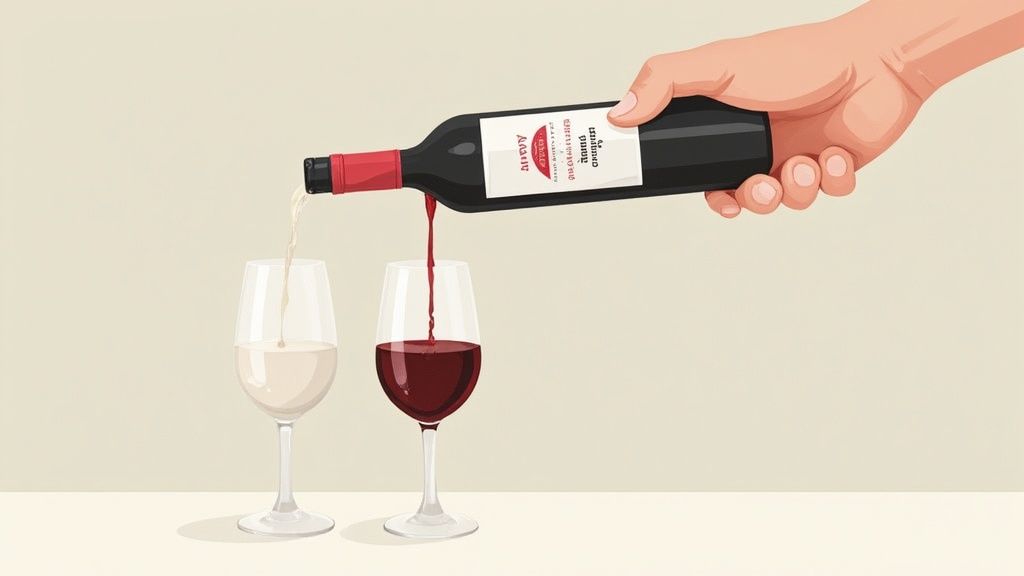Port wine is best enjoyed slightly chilled, sipped slowly from a small wine glass to let its rich, complex flavours unfold. If you're new to Port, I'd suggest starting with a versatile Ruby or a nutty Tawny. Just make sure to serve it a bit cooler than you would a standard red wine—this helps to balance its natural sweetness and alcohol content perfectly.
Your First Pour: A Beginner's Guide to Port

Diving into the world of Port can feel like you're uncovering a well-kept secret, often pictured alongside stuffy dinners or complicated rituals. But honestly, learning how to drink Port is surprisingly straightforward and incredibly rewarding. Forget the old notion that it’s strictly for dessert; this fortified wine offers a whole spectrum of styles perfect for all sorts of moments.
This guide is your practical starting point. We'll demystify the basics and help you enjoy that first glass with the confidence of a seasoned enthusiast.
Ruby vs. Tawny: Your First Choice
When you’re starting out, you’ll almost certainly come across two main styles: Ruby and Tawny. Getting your head around their key differences is the first step to figuring out what you like.
- Ruby Port: This is your vibrant, fruit-forward option. It's aged for just a few years in massive vats, which helps it hang onto that deep red colour and punchy notes of blackberry, raspberry, and cherry. It’s bold, sweet, and a brilliant entry point.
- Tawny Port: This style is aged longer, but in smaller wooden barrels, which allows for gradual oxidation. This whole process gives it that beautiful amber or "tawny" colour and develops wonderfully complex flavours of caramel, toasted nuts, and dried fruit.
For a first taste, a quality Ruby Port is a fantastic choice for its straightforward fruity character. If you prefer nuttier, more mellow flavours like those in a sherry or an aged whiskey, a 10-Year-Old Tawny will be more your style.
Why Temperature and Glassware Matter
Two simple details can transform a good glass of Port into a great one: the serving temperature and the right glass. Most people serve Port way too warm, which makes the alcohol taste harsh and overpowering. You want to aim for a temperature between 10–16°C. A quick 20 minutes in the fridge is usually all it takes.
Using a smaller glass designed for fortified wines is also a game-changer. It helps concentrate the intense aromas, allowing you to appreciate every little nuance. If you're keen to explore these ideas further, our complete guide to fortified wines takes a deeper look into their unique characteristics. It’s great to see the Australian fortified wine scene growing, especially in restaurants across Melbourne and Sydney, making it easier than ever to try a glass served just right.
Preparing Your Bottle of Port

Choosing your bottle of Port is the exciting first step, but the real magic happens in the preparation. How you handle the bottle just before serving is what unlocks its true character, turning a simple drink into a memorable experience. This isn't about complicated rituals; it’s about a few simple actions that make a world of difference.
Most Ports you'll find on the shelf, like your everyday Ruby and Tawny, are good to go straight from the bottle. Easy. However, certain styles develop a natural sediment over years of ageing. While completely harmless, it's gritty and honestly not very pleasant to drink. This is where decanting becomes your best friend.
When and How to Decant Port
The two main styles that absolutely require decanting are Vintage Port and Crusted Port. These are bottled unfiltered, which means they do their maturing in the bottle, creating that fine layer of sediment over time.
Decanting really does two key things for these wines:
- It separates the clear wine from that gritty sediment at the bottom.
- Just as importantly, it lets the wine breathe. This helps soften its powerful structure and opens up all those complex, beautiful aromas.
And don't worry if you don’t own a fancy crystal decanter. Any clean glass jug or even a simple carafe will do the job perfectly. The goal is just to pour the wine off its sediment.
To get it right, stand the bottle upright for at least 24 hours before you plan to open it. This gives all the sediment time to settle nicely at the bottom. When you're ready, pour the wine slowly and steadily into your decanter in one continuous motion. A little trick I use is holding my phone's torch under the bottle's neck. It lights up the wine and helps you spot the sediment as it nears the opening, so you know exactly when to stop pouring.
A common question is how long to let it breathe. For a young Vintage Port (say, under 15 years), let it sit in the decanter for about two to three hours. For a much older vintage (40+ years), the aromas are more delicate, so you might only decant it 30 minutes before serving.
Getting the Serving Temperature Just Right
Just as crucial as decanting is the serving temperature. This single detail can completely change how you experience Port, balancing its sweetness and high alcohol for a smoother, more enjoyable sip. The ideal temperature really depends on the style.
- Ruby and basic Tawny Ports are best served slightly chilled, around 12-16°C.
- Aged Tawny and Vintage Ports benefit from being a little warmer, around 16-18°C, to really showcase their complex nutty and dried fruit notes.
- White and Rosé Ports should be served properly chilled, just like you would a white wine, at 4-10°C.
You don’t need anything fancy here. A simple 20-30 minutes in the fridge before opening is usually enough to bring your Port to the perfect temperature. This quick chill ensures the flavours are expressive and the alcohol doesn't overpower the whole experience.
The Ritual of Serving Port

There’s something special about serving Port. It’s not about being stuffy or overly formal; it's about paying attention to a few small details that can turn a simple drink into a memorable experience. From the glass you choose to the way you pour, each step is a nod to the craftsmanship in the bottle.
First things first, let's talk glassware. A traditional Port glass, with its smaller bowl and slightly tapered opening, is designed for a reason. It’s not just for show—this specific shape concentrates the wine’s intense, complex aromas, funnelling them perfectly with every sip.
If you don’t have dedicated Port glasses on hand, don't worry. A standard white wine glass is your next best bet. Its smaller bowl does a much better job than a large red wine glass, which can let all those beautiful aromatics escape and get lost.
Perfecting the Pour
When it comes to serving Port, remember that less is more. The standard serving size is smaller than you might think, typically around 75ml, which is about half of a standard wine pour. This is because Port is richer, sweeter, and higher in alcohol, so a little goes a very long way.
This smaller serve also encourages you to slow down, to sip and savour the wine, appreciating its incredible depth and long, lingering finish. While it has a loyal following, fortified wines only make up a tiny fraction—about 2-3%—of total wine sales in Australian bars and restaurants. This makes every glass feel like a special indulgence. You can dig deeper into the Australian fortified wine market to see how these trends are shaping up.
Thinking of serving Port at a dinner party? There’s a wonderful, time-honoured tradition for that. It’s customary for the host to pour a glass for the person on their right, then pass the decanter to the left. The bottle keeps moving clockwise around the table until everyone has been served.
The tradition of "passing the Port to the left" is thought to have naval origins, where the command "port side" refers to the left. It’s a simple, elegant way to ensure the bottle keeps moving and no one's glass stays empty for long.
Adopting these simple practices—the right glass, a modest pour, and a touch of tradition—turns the act of drinking Port into a genuine ritual. It’s a fantastic way to show respect for the wine and create a more engaging, sophisticated moment for you and your guests.
How to Taste Port Like an Expert

Tasting Port is a complete sensory experience, and you certainly don’t need to be a sommelier to appreciate its depth. It’s really all about slowing down and noticing the little details that make each style so unique. The whole process breaks down into three simple stages: sight, smell, and taste.
First, take a moment to look at the wine’s colour, preferably against a white background like a napkin. A young Ruby Port will have a vibrant, deep red hue, hinting at the bold fruit flavours to come. On the other hand, an aged Tawny will show off a beautiful pale amber or brownish colour—a dead giveaway of its long, slow maturation in wooden barrels.
Unlocking the Aromas
Now for the fun part. Give the glass a gentle swirl. This simple action aerates the wine, releasing its complex bouquet of aromas. Don't be shy—get your nose right in there and take a proper sniff.
So, what are you smelling?
- Younger Ports: You’ll often find fresh berries like raspberry and blackberry, sometimes with a lovely touch of spice.
- Aged Ports: These tend to showcase more complex scents of dried fruit, toasted nuts, caramel, and even a hint of chocolate or cinnamon.
The key is to take your time and see what scents you can pick out. Each swirl might reveal something new as the wine opens up, telling the story of its journey from grape to glass.
Finally, take a small sip and let the Port coat your entire palate. Notice its texture—is it smooth and silky or rich and full-bodied? Pay close attention to the balance between sweetness and acidity, and see how the flavours evolve on your tongue. The best Ports have a long, lingering finish that stays with you long after you’ve taken a sip.
If you enjoy this mindful approach to tasting, you might be interested in our guide on how to taste like a sommelier, which offers more great tips for developing your palate.
Finding the Perfect Port and Food Pairings
One of the best things about Port is just how versatile it is with food. When you learn how to drink Port, exploring these combinations is half the fun. You can create some seriously delicious moments that go way beyond the expected.
The most celebrated partnership, without a doubt, is a rich, fruity Ruby Port served alongside a wedge of salty blue cheese like Stilton. It's a classic for a reason.
The magic is all in the contrast. The Port’s intense sweetness and bold fruit cut straight through the cheese's salty, creamy richness, creating an incredible balance on your palate. To really elevate the experience, try presenting your cheese and other nibbles on beautiful, rustic charcuterie serving trays—it adds a touch of class to the occasion.
Sweet and Savoury Companions
Of course, dessert is Port’s natural playground. A nutty, caramel-toned Tawny Port is absolutely stunning with crème brûlée, almond tarts, or even a simple handful of toasted walnuts. For the chocolate lovers, the bold berry notes in a Ruby Port are the perfect match for the intensity of a dark chocolate lava cake or a decadent brownie.
But the journey doesn't stop there. Port can be a fantastic companion to a wide range of savoury foods, too. Picture a platter piled with cured meats, toasted almonds, and hard, aged cheeses. The wine’s structure and sweetness provide a brilliant counterpoint to all those salty, umami flavours.
Pairing Port with cheese and chocolate is a well-established tradition around the world, and it’s a trend that continues to grow right here in Australia. In fact, you might find Port offered alongside a cheese platter in up to 30% of wine-focused restaurants.
Don’t be afraid to experiment a little. A slightly chilled Tawny Port with a rich pâté can be a game-changer, as can a robust Ruby with a gamey dish like duck. The real goal is to find combinations that you personally love.
To help you get started, we've put together a quick guide to some classic pairings.
Classic Port and Food Pairings
This table offers a starting point for pairing different Port styles, helping you create the perfect match every time.
| Port Style | Classic Cheese Pairing | Dessert Pairing | Savoury Pairing |
|---|---|---|---|
| Ruby Port | Stilton, Roquefort, or other bold blue cheeses. | Dark chocolate cake, berry tarts, brownies. | Cured meats, sharp cheddar, walnuts. |
| Tawny Port | Aged cheddar, Manchego, Parmesan. | Crème brûlée, almond tart, pecan pie. | Pâté, roasted nuts, figs with prosciutto. |
| Late Bottled Vintage (LBV) | Gorgonzola, aged Gouda. | Chocolate-covered cherries, rich fruit cake. | Duck confit, venison, rich stews. |
| Vintage Port | Stilton is the ultimate classic pairing. | Minimalist pairings like high-quality dark chocolate. | Best enjoyed on its own or with a simple cheese. |
These are just suggestions, of course. Creating these moments is all about discovering harmonies between wine and food that excite your own palate.
For those keen to dive deeper into the art of matching wine and cheese, check out our guide on creating the perfect wine and cheese pairings.
Common Questions About Drinking Port
Even after you get the basics down, a few practical questions always seem to pop up when you start enjoying Port at home. Knowing how to store an open bottle or whether it’s okay to mix it into a drink can make the whole experience feel a lot more relaxed. Let's tackle some of the most common queries we hear.
How Long Does Port Last After Opening?
This really comes down to the style of Port you're drinking. A Tawny Port, having already been exposed to plenty of oxygen during its long life in barrels, is pretty resilient. You can pop an opened bottle in the fridge and it will stay fresh for several weeks, sometimes even up to a couple of months, without losing its charm.
On the other hand, a Vintage Port is far more delicate. It ages in the bottle, sealed away from air, so its complex aromas and flavours start to fade quickly once the cork is pulled. To get the best out of it, you’ll want to finish the bottle within two to three days.
Should I Store Port in the Fridge?
Once it's open, the answer is a definite yes. Sticking any style of Port in the fridge is the best way to slow down oxidation and preserve its freshness. Just make sure you seal it up tightly with its original cork or a decent wine stopper.
For unopened bottles, treat them just like any other fine wine. Store them on their side in a cool, dark place with a stable temperature to keep them in perfect condition for years to come.
A common misconception is that all Port should be served at room temperature. Storing an open bottle in the fridge not only preserves it but also brings it down to the correct, slightly chilled temperature, which really makes its vibrant flavours sing.
Can You Use Port in Cocktails?
Absolutely! Port is surprisingly versatile and makes a fantastic cocktail ingredient. In Portugal, a 'Porto Tónico'—made with White Port and tonic water—is a hugely popular and refreshing aperitif, perfect for a warm afternoon.
A good quality Ruby Port can also add incredible depth and sweetness to classic cocktails. Try adding a splash to a New York Sour or simply mix it with ginger ale and a slice of lime for a delicious, easy-drinking long drink. It’s a great way to enjoy Port in a more casual, modern style.




Comments (0)
There are no comments for this article. Be the first one to leave a message!